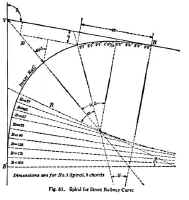|
 Article taken from "Backsights"
Magazine published by Surveyors Historical Society
Article taken from "Backsights"
Magazine published by Surveyors Historical Society
|
TROLLEY AS COST
EFFICIENT TRANSIT
by Rick Zimmerman
From
the Electric Railroads chapter by Wm. A. Delmar in Mansfield Merriam's
American
Civil Engineers' Handbook, 1920, 4th edition.
As
the 1920's opened, the electric railroad (street cars or trolleys) had a virtual
monopoly for street and inter-urban mass transportation systems because of its
energy efficient use. The power to drive the train was concentrated in a
single central plant.
Coal
provided a common denominator for efficiency comparisons. Even though
electric power required a larger initial capital expenditure, electric traction
required having the amount of coal per car needed with steam traction.
Nearby water power for electric generation often made the electric power for
mass transit a certainty for lower costs.
The
layout surveyed for an electric trolley line had a direct bearing on its
prospects for economic success. A curve always gives rise to a retarding
force in the train, increasing operating costs, and slowing timetables.
Each degree of curvature was taken as an equivalent to an up grade of 0.05%.
For
easy curves, spirals (or transition curves) were borrowed directly from those in
general use for steam railway work (see Merriam's chapter on Steam
Railroads). However, curves around street corners were usually so sharp
that "special work" spirals had to be generated, allowing for more
rapid changes of curvature. These were applied in trolley line layouts as
branch-offs, Y's, as well as approaches to single curves.
The
critical items required from the engineer were: (a) the total central
angle of the curve, (b) the total required clearance of center of curve between
curb and nearest rail and (c) the distance from rails to curb in each
street. Spacing between track centers for double track or turnouts
depended not only on overall car width, but also on the speed of the cars
traveling through the curve.
 The
following example of a spiral was taken by Merriam's from Wm. Wharton Jr. &
Co., Inc.. Four spirals of the multi-form-compound curve class were
developed, each with a common base pictured in spiral No. 1 (fig. 51). The
other spirals were derived from it by multiplying the functions of the common
base spirals by the figures using a table. The use of each spiral was
limited to curves with an upper limit radius. The
following example of a spiral was taken by Merriam's from Wm. Wharton Jr. &
Co., Inc.. Four spirals of the multi-form-compound curve class were
developed, each with a common base pictured in spiral No. 1 (fig. 51). The
other spirals were derived from it by multiplying the functions of the common
base spirals by the figures using a table. The use of each spiral was
limited to curves with an upper limit radius.
Applying
this system, switches could be set into the plain ends of curves without
changing the lines. The curves in the table are those of the inner rail
gage line, not the center line of the track as in steam railway work.
Merriams's also used Wharton's system for selecting a curve with spirals, for
example, to lay out a track inside a curving parallel highway.
A
system to determine spacing of turnouts on single track roads is included in the
fourth edition of Merriam's. Here, variables are reduced to a common time
denominator: number of trains, engines per train, number of cars per
train, grades along legs of the road, excessive curvature, and speed in
populated areas. All of these increase time in the same way that distance
does. Location of the turnouts is determined graphically by scaling off a
worksheet.
Trolleys
may yet again be cost effective alternatives to private transportation as the
cost of gasoline goes up, and electric costs come down.
| 